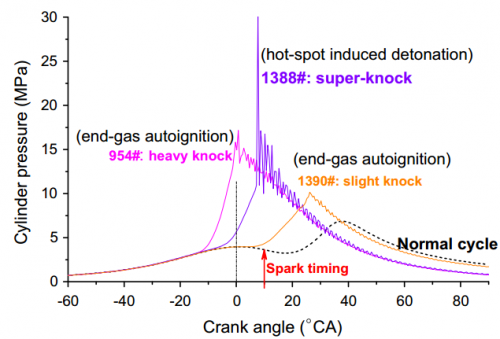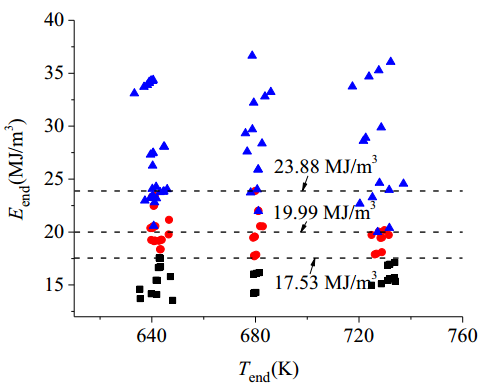直喷增压小排量是汽油机节油有效途径。但随着增压比提高(负荷增大至20bar以上平均有效压力BMEP时),出现了新的敲缸模式,极具破坏性,瞬时缸内压力甚至超过400bar,德国大众VW(2005)称为Unwanted Pre-ignition (不希望的早燃),奥地利AVL(2009)称为Mega Knock (大爆震), 英国Shell (2009)称之为Super-knock(超爆),美国西南研究院SWRI (2011)称为LSPI(低速早燃), 清华大学(2006)称之为 “超级爆震”(因超级爆震压力震幅△p>5.0MPa,超过常规爆震1~2个数量级以上, 因此我们在2006年国家863项目研究报告中把它叫做“

发动机中的“超级爆震”通常是由炽热的机油或者颗粒物引起的早燃,进而引发爆轰的过程,与传统的末端自燃引起的压力震荡(常规爆震)不同,超级爆震一般出现在高功率汽油机的低速大负荷工况,压力震荡幅值超过常规爆震一个数量级,破坏力极强,也常被称作低速早燃(LSPI)。本课题组通过快速压缩机首次观察到爆轰的产生,揭示了“超级爆震”爆轰燃烧的本质:早燃—>末端自燃—>爆轰。

通过快速压缩机和发动机中的变工况研究,发现了早燃是超级爆震发生的必要非充分条件,进而得到了不同的初始热力学条件对起爆的影响,其中能量密度的影响主导,而温度的作用并不明显。

代表性论文:
- Y. Qi, Y. Xu, Z. Wang, J. Wang, The effect of oil intrusion on super knock in gasoline engine, SAE Technical Papers (2014).
- Z. Wang, H. Liu, T. Song, Y. Xu, J.X. Wang, D.S. Li, T. Chen, Investigation on pre-ignition and super-knock in highly boosted gasoline direct injection engines, SAE Technical Papers (2014).
- Z. Wang, F. Wang, S.J. Shuai, Study of Engine Knock in HCCI Combustion using Large Eddy Simulation and Complex Chemical Kinetics, SAE Technical Papers (2014).
- Z. Wang, H. Liu, T. Song, Y. Qi, X. He, S. Shuai, J. Wang, Relationship between super-knock and pre-ignition, International Journal of Engine Research 16 (2015) 166-180.
- Z. Wang, Y. Qi, X. He, J. Wang, S. Shuai, C.K. Law, Analysis of pre-ignition to super-knock: Hotspot-induced deflagration to detonation, Fuel 144 (2015) 222-227.
- Y. Qi, Z. Wang, J. Wang, X. He, Effects of thermodynamic conditions on the end gas combustion mode associated with engine knock, Combustion and Flame 162 (2015) 4119-4128.
- Z. Wang, H. Liu, R.D. Reitz, Knocking combustion in spark-ignition engines, Progress in Energy and Combustion Science 61 (2017) 78-112.

